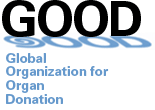Donate Life
The Donation Process
Trauma Scene/Cause of Deaths
Most organ donors die as the result of accidents that cause fatal head injuries, like auto accidents, although many donors are victims of strokes or bleeding in the brain.
Transport
A highly specialized medical team of paramedics and emergency medical techniques (EMTs) begin life-saving efforts at the accident scene. They communicate with emergency room doctors during transport to the hospital.
Emergency Room (ER)
Doctors and nurses have advanced life-support equiment ready when the ambolance or helicopter arrives. The evaluate injuries and continue life-saving measures including a respirator (breathing machine), IV fluid and blood replacemen, and drugs to help the heart keep beating. When the patient's vital signs stabilize, he is transferred to an intensive care unit (ICU).
Intensive Care Unit (ICU)
A doctor does special tests to see how much damage has been done to the brain and the body. During these tests, the medican team continues advanced life-support treatment.
Brain Death
If a patient is in a coma, tests show whether there is brain activity and blood flowing through the brain. If tests show there is no blood supply to the brain, and no electrrical activity, it is completely destroyed and can never work again. Despite the fact that the patient is on a respirator, If all tests show the brain is no longer alive, the doctor tells the family the patient has died.
Refferal/Evaluation
A coordinator from the local Organ Procurement Organization (OPO), specially trained in organ recovery, goes to the hospital to see if the patient is medically suitable to be an organ donor. If in a state with a donor registry, the coordinator will first check to see if the potential donor's name is on the registry. In many states, donor registration constitutes consent for donation, in others, the decision is left to the next of kin. Even after the patient dies, the ventilator provides oxygen to the major organs until consent for donation is obtained.
Family Consent
Consent from the family is only necessary if the potential has not registered his/her wishes about donation. In that case, the next of kin will be approached for consent. After telling the family the patient has died, the medical team explains organ donation. The family is given time to decide. The decision is much easier if the family has already discussed organ donation. Once the donation decision is made, the family can make funeral plans. Only now is a patient called a "donor". All hospital costs from this point are paid by the organ donation center or OPO.
Organ Placement
The donor's blood type, size and hospital are entered into the national computer to find patients awaiting transplants that best match the donor's heart, lungs, liver, kidneys, and pancreas. Patients are matched to organs based on a number of factors including blood tissue typing, medical urgency, time on waiting list, and geographical location. If the organ donor was also a tissue donor, recipients for corneas (eyes), skin and bones are identified later.
Organ Recovery
In some cases, a recipient's surgical team will come to the hospital to remove the donor's organ for their patient. In others, local surgeons will remove organs, and organ recovery coordinators will pack them and ship them to the transplant centers. Like other operations, this surgery takes place in an operating room.
Funeral Arrangements
After donation, the donor's body is taken to the funeral home of the family's choice. The funeral is not delayed. The family can even have an open casket funeral if they want because the person looks the same as before.
Follow-up
About two weeks later, the donor's family receives a letter from the donation center (OPO) telling them, in general terms, where organs and tissues went and who received them. Actual names of donors and recipients, and where they live, are kept confidential. Donor families can get updates about recipients anytime by calling the donation center. Anonymous correspondence between donor families and recipients can be facilitates by the OPO and the transplant center. Donor families usually enjoy getting letters from recipients so they know how they are doing. And, many recipients are eager to know something about the donor and his/her family.
Links and Downloads
Register as a donor online: www.lifeshareregistry.org
Download a Family Notification Card



